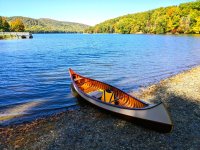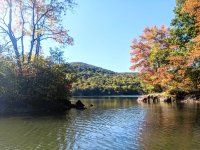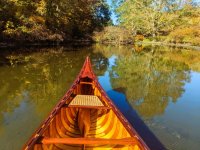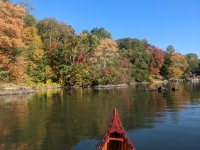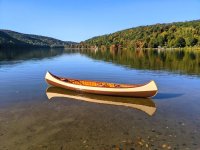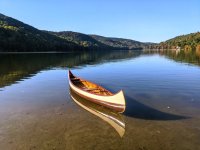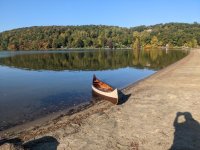This is a follow-on to this thread:
Posts like Al's were very helpful to me psychologically. So, I got a trailer and finally hit the waters and shores of five northwest Connecticut waterbodies to test out my soloized 15' B.N. Morris reproduction (by Rollin Thurlow) canoe.
Frankly, I didn't have high expectations for its performance. I assumed it was mostly a pretty boy pleasure canoe that would be slow and a poor turner, especially with its full keel. I was wrong. It's not as fast, of course, as my skinny solo canoes such as my Lotus BJX or Hemlock SRT, or as turny as my freestyle Bell Wildfire, but it is faster and a better turner as a solo canoe than my 15' Nova Craft Bob Special. I was unexpectedly impressed. And the visual aesthetics of looking at the red cedar, white cedar and mahogany wood interior as you paddle is unbeatable.
Let's take five trips as I experiment with different paddles, kneeling cushions and wind conditions.
Here is my old van and new trailer on my unmowed lawn ready for the Morris' first trip.
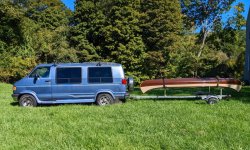
The Morris received its first watery baptism in Winchester Lake, using my Bruce Smith ottertail paddle and my custom designed (by me) and custom made (by Brad Gillespie) Gillespie Free paddle. I ended up somewhat preferring the Gillespie because it provides more power per stroke, auto-rolls better, has a longer shaft for bow stroke reach and turning bite, and is more useful in shallow waters.
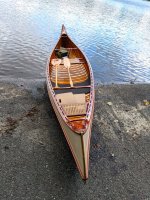
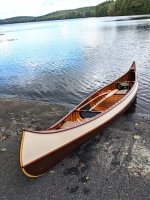
I experimented with a ⅜" ensolite pad and two 1½" high density EVA kneeling pads. I mostly used both together because, even though I lowered the seat one inch, it is still a bit too high for comfortable kneeling.
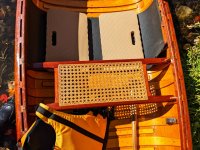
Kneeling allows three-point contact with the hull and enables me to generate more power and to better reach the forward quadrants of the canoe for bow strokes than sitting does. I am able switch to a sitting position very easily under the seat height and across the smoothly half-ribbed floor, and I experimented with a variety of leg positions while seated. However, with only one point of contact (seat on seat), I feel I can generate only about 70% of the power per stroke that I can when kneeling—unless I'm seated with a foot bar, which I'm not going to install on a wood-canvas canoe. Seated paddling is not for me, except as a respite from kneeling for my bent feet and ankles.
Winchester Lake has some nice coves full of lily pads and flocks of geese that you can't see in these pictures.
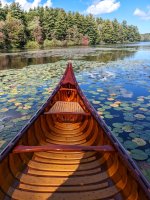
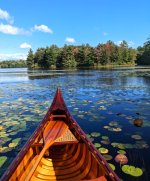
There are also two giant wind turbines over the north end of the lake, which you can see in this picture.
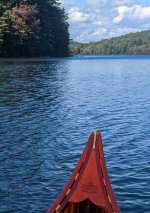
Hey, Glenn! Maybe lakes near wind turbines aren't ideal! Sure enough, the wind started to pick up—not a big or dangerous blow, but pretty stiff with gusting cat's paws.
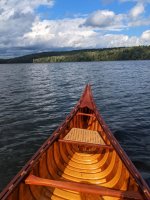
The wind provided the biggest surprise to me of all about the Morris' performance. I expected it to get blown all over, especially with those high, upswept ends. However, to the contrary, it's almost completely wind neutral. It doesn't wind cock or lee cock and is virtually unaffected by wind direction, whether I paddled with wind from the front, rear, front quarter, rear quarter, or straight across. It's the best solo wind boat that I own or have ever paddled. My asymmetrical solo canoes do some very asymmetrical things in wind, especially rear winds.
I attribute the Morris' excellent wind neutrality partly to the keel and mostly to the well-centralized solo seat. To me, paddling a tandem canoe solo, bow seat backwards, as I have to do in my Bob Special, is a chore and the pits. I really can't stand it. I have to put 40-50 lbs. of fake ballast in the bow to get a level trim, and I can't properly reach the front quarters for effective bow control strokes. This all makes turning difficult and stodgy, and an inefficient way to paddle solo for me unless my only paddling interest was forward stroking with a heavy load in the bow. That's not how or why I paddle. A centralized solo seat solves all these issues along with being the best position for wind neutrality.
The second place I paddled is the closest spot to home, Housatonic River/Lake Lillinonah. For this trip I added two bent shaft paddles, a double-scoop power face Sawyer Manta and a curved carbon blade, double bend Mitchell Leader.
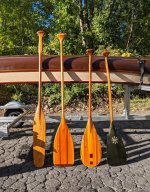
Here is Lovers Leap Gorge where Indian Princess Lillinonah, who was unable to marry her white man lover, killed herself going over a waterfall in the gorge, which caused her lover to leap from the cliffs to his own death.
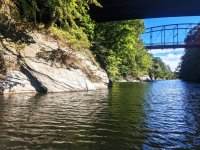
I survived the transit of the gorge alive, which then opens up into a view of a quaint red New England farm house. You can see invasive Eurasian milfoil in the waters close to shore.
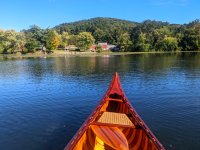
Around the bend from the flag, you can get a glimpse of some more Eurasian milfoil on the water.
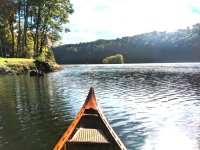
As to the paddles, for decades I have primarily been a single-sided paddler with bent shaft paddles on flat water. However, I didn't care as much for either bent shaft in the Morris. First, since I kneel or sit higher in the Morris than in any of my other five flat water solo canoes, the two 50" bents felt a bit short. A 52" Wenonah carbon bent shaft paddle, which I used on a later lake, was a better fit, but I think it's somewhat heretical, if not sinful, to use a carbon paddle in a wood-canvas canoe. Second, it's harder to do a J correction with a bent shaft than a straight shaft, and I think the Morris' full keel made bent shaft correction even a bit more difficult. I'll probably stick with straight wooden paddles in the Morris.
Here I am returning to the put-in, where my magic bus van and trailer await.
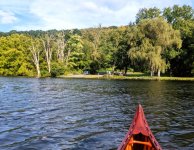
The Morris' third trip was on Pond Brook/Lake Lillinonah and then part way up a tributary, the Shepaug River. For this trip I added my 54" Lutra 2.5° S blade, which was my go-to flat water "straight" paddle from 1984, when I bought it from Bardy Jones in the Everglades, until I designed my Gillespie Free in 2009.
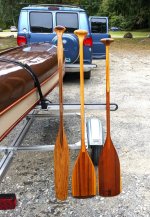
I didn't care for the Lutra paddle in the Morris as much as the Gillespie or the Smith ottertail. Too short. But I enjoyed noodling along the shore of Pond Brook, even though the waters were murky green with algae . . .
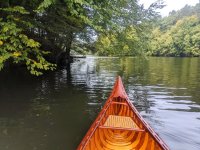
. . . and paddling up to a small rock island with one lonely tree . . .
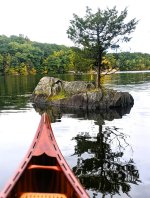
. . . and looking down the length of Lillinonah to the bridge in the far distance, which takes one to Mia Farrow's house in Bridgewater, who (sigh) has never offered to paddle with me.
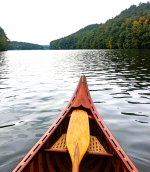
The fourth outing for the Morris was a new lake for me, Stillwater Pond, a shallow reservoir with a small dam at one end. It was a gorgeous, cloudless day with virtually no wind. I love paddling on glass.
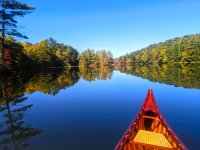
Because the water is shallow and we've had so much heat, this was another lake with murky green water in places, albeit ungreening trees.
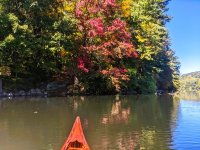
Other shallow places had lovely beds of lily pads.
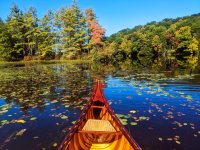
On one small island of various vegetation, white flowers caught my eye. Queen Anne's Lace, perhaps.
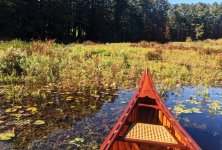
I heard babbling water as I paddled back along the far shore, and found a starved brook when I poked the canoe into a narrow cove.
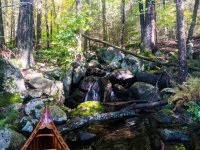
As I paddled out of the brook cove, I spotted a white contrail in the blue sky and reflecting in the water. If you look close there are actually two contrails in the sky.
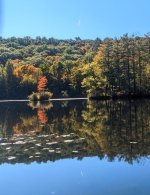
As I was Indian stroking and side-slipping along the shore, I spotted the dam through the changeling branches of an overhanging tree.
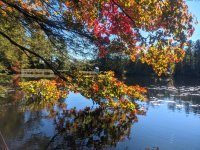
Fearless former whitewater paddler, I paddled up to the dam's spillway to see if I could get a look at what seems to be about a 25' drop, but not close enough that accelerating waters could suck me over the precipice.
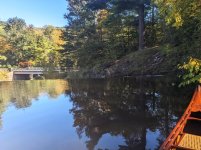
I finished Stillwater Pond and a few days later explored another new lake to me, Burr Pond, which I discovered when registering my trailer in a new town.
Although I remain the world's worst trailer backer-upper, at this put-in I was brave enough to back right into the water. I was then able to turn the canoe right-side up on the trailer bars and slide it backwards right into the water. Splash. No lifting. No cart wheels. I did the same when I took out after the paddle.
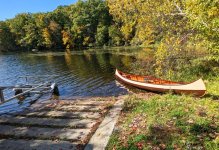
Burr is a very interesting and variegated pond with several arms and coves, big boulders above and just below the surface, islands, a state beach, another spill dam, and very clear waters (thank goodness, so I could see the underwater boulders). Right away, I came upon a beaver lodge.
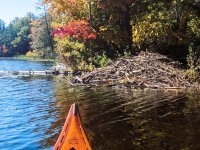
A small island was separated from the shore by a narrow water path. Should I go through it?
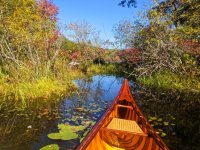
I didn't. Not because I thought I couldn't do it, but because I didn't want to risk scratching my new canoe on the shallow bottom or by the branches on the sides. I would have gone through with any of my composite canoes.
I did go between some islands . . .
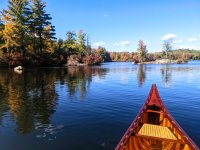
. . . and ended the day sunning myself on the other side of the state beach peninsula, and contemplating my beautiful new wood-canvas canoe.
Bottom line: The Morris is the quietest canoe I have ever paddled. No wave slap. Silent slicing. It is the most wind neutral of all my canoes. It has adequate speed and makes a nice turn when moderately heeled, even with the keel. It has much more initial stability than narrow solo canoes, which promotes confidence when shifting from knees to sitting and when getting in and out, and it has very strong secondary stability for its 30.5" plank-to-plank width. Finally, the visual aesthetics—just looking at the rich wood colors while I paddle—are unsurpassed. Far better than any plastic or composite canoe I have ever paddled.
Even though it's too heavy for me to portage at my age, I am so glad I bought the canoe and the very useful trailer. My Morris is a joy.
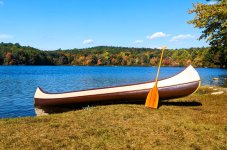
I Can't Lift/Transport My Morris Canoe! . . . or can I?
So, I bought this beautiful Rollin Thurlow reproduction of a B.N. Morris 15' canoe. I wrote all about the canoe in this thread: https://www.canoetripping.net/threads/couldnt-resist-15-b-n-morris-customized-reproduction-by-rollin-thurlow-in-as-new-condition.127744/ But it was time to stop...
www.canoetripping.net
Handsome canoe! It deserves to be see water even if it means picking up some scratches along the way.
Posts like Al's were very helpful to me psychologically. So, I got a trailer and finally hit the waters and shores of five northwest Connecticut waterbodies to test out my soloized 15' B.N. Morris reproduction (by Rollin Thurlow) canoe.
Frankly, I didn't have high expectations for its performance. I assumed it was mostly a pretty boy pleasure canoe that would be slow and a poor turner, especially with its full keel. I was wrong. It's not as fast, of course, as my skinny solo canoes such as my Lotus BJX or Hemlock SRT, or as turny as my freestyle Bell Wildfire, but it is faster and a better turner as a solo canoe than my 15' Nova Craft Bob Special. I was unexpectedly impressed. And the visual aesthetics of looking at the red cedar, white cedar and mahogany wood interior as you paddle is unbeatable.
Let's take five trips as I experiment with different paddles, kneeling cushions and wind conditions.
Here is my old van and new trailer on my unmowed lawn ready for the Morris' first trip.

The Morris received its first watery baptism in Winchester Lake, using my Bruce Smith ottertail paddle and my custom designed (by me) and custom made (by Brad Gillespie) Gillespie Free paddle. I ended up somewhat preferring the Gillespie because it provides more power per stroke, auto-rolls better, has a longer shaft for bow stroke reach and turning bite, and is more useful in shallow waters.


I experimented with a ⅜" ensolite pad and two 1½" high density EVA kneeling pads. I mostly used both together because, even though I lowered the seat one inch, it is still a bit too high for comfortable kneeling.

Kneeling allows three-point contact with the hull and enables me to generate more power and to better reach the forward quadrants of the canoe for bow strokes than sitting does. I am able switch to a sitting position very easily under the seat height and across the smoothly half-ribbed floor, and I experimented with a variety of leg positions while seated. However, with only one point of contact (seat on seat), I feel I can generate only about 70% of the power per stroke that I can when kneeling—unless I'm seated with a foot bar, which I'm not going to install on a wood-canvas canoe. Seated paddling is not for me, except as a respite from kneeling for my bent feet and ankles.
Winchester Lake has some nice coves full of lily pads and flocks of geese that you can't see in these pictures.


There are also two giant wind turbines over the north end of the lake, which you can see in this picture.

Hey, Glenn! Maybe lakes near wind turbines aren't ideal! Sure enough, the wind started to pick up—not a big or dangerous blow, but pretty stiff with gusting cat's paws.

The wind provided the biggest surprise to me of all about the Morris' performance. I expected it to get blown all over, especially with those high, upswept ends. However, to the contrary, it's almost completely wind neutral. It doesn't wind cock or lee cock and is virtually unaffected by wind direction, whether I paddled with wind from the front, rear, front quarter, rear quarter, or straight across. It's the best solo wind boat that I own or have ever paddled. My asymmetrical solo canoes do some very asymmetrical things in wind, especially rear winds.
I attribute the Morris' excellent wind neutrality partly to the keel and mostly to the well-centralized solo seat. To me, paddling a tandem canoe solo, bow seat backwards, as I have to do in my Bob Special, is a chore and the pits. I really can't stand it. I have to put 40-50 lbs. of fake ballast in the bow to get a level trim, and I can't properly reach the front quarters for effective bow control strokes. This all makes turning difficult and stodgy, and an inefficient way to paddle solo for me unless my only paddling interest was forward stroking with a heavy load in the bow. That's not how or why I paddle. A centralized solo seat solves all these issues along with being the best position for wind neutrality.
The second place I paddled is the closest spot to home, Housatonic River/Lake Lillinonah. For this trip I added two bent shaft paddles, a double-scoop power face Sawyer Manta and a curved carbon blade, double bend Mitchell Leader.

Here is Lovers Leap Gorge where Indian Princess Lillinonah, who was unable to marry her white man lover, killed herself going over a waterfall in the gorge, which caused her lover to leap from the cliffs to his own death.

I survived the transit of the gorge alive, which then opens up into a view of a quaint red New England farm house. You can see invasive Eurasian milfoil in the waters close to shore.

Around the bend from the flag, you can get a glimpse of some more Eurasian milfoil on the water.

As to the paddles, for decades I have primarily been a single-sided paddler with bent shaft paddles on flat water. However, I didn't care as much for either bent shaft in the Morris. First, since I kneel or sit higher in the Morris than in any of my other five flat water solo canoes, the two 50" bents felt a bit short. A 52" Wenonah carbon bent shaft paddle, which I used on a later lake, was a better fit, but I think it's somewhat heretical, if not sinful, to use a carbon paddle in a wood-canvas canoe. Second, it's harder to do a J correction with a bent shaft than a straight shaft, and I think the Morris' full keel made bent shaft correction even a bit more difficult. I'll probably stick with straight wooden paddles in the Morris.
Here I am returning to the put-in, where my magic bus van and trailer await.

The Morris' third trip was on Pond Brook/Lake Lillinonah and then part way up a tributary, the Shepaug River. For this trip I added my 54" Lutra 2.5° S blade, which was my go-to flat water "straight" paddle from 1984, when I bought it from Bardy Jones in the Everglades, until I designed my Gillespie Free in 2009.

I didn't care for the Lutra paddle in the Morris as much as the Gillespie or the Smith ottertail. Too short. But I enjoyed noodling along the shore of Pond Brook, even though the waters were murky green with algae . . .

. . . and paddling up to a small rock island with one lonely tree . . .

. . . and looking down the length of Lillinonah to the bridge in the far distance, which takes one to Mia Farrow's house in Bridgewater, who (sigh) has never offered to paddle with me.

The fourth outing for the Morris was a new lake for me, Stillwater Pond, a shallow reservoir with a small dam at one end. It was a gorgeous, cloudless day with virtually no wind. I love paddling on glass.

Because the water is shallow and we've had so much heat, this was another lake with murky green water in places, albeit ungreening trees.

Other shallow places had lovely beds of lily pads.

On one small island of various vegetation, white flowers caught my eye. Queen Anne's Lace, perhaps.

I heard babbling water as I paddled back along the far shore, and found a starved brook when I poked the canoe into a narrow cove.

As I paddled out of the brook cove, I spotted a white contrail in the blue sky and reflecting in the water. If you look close there are actually two contrails in the sky.

As I was Indian stroking and side-slipping along the shore, I spotted the dam through the changeling branches of an overhanging tree.

Fearless former whitewater paddler, I paddled up to the dam's spillway to see if I could get a look at what seems to be about a 25' drop, but not close enough that accelerating waters could suck me over the precipice.

I finished Stillwater Pond and a few days later explored another new lake to me, Burr Pond, which I discovered when registering my trailer in a new town.
Although I remain the world's worst trailer backer-upper, at this put-in I was brave enough to back right into the water. I was then able to turn the canoe right-side up on the trailer bars and slide it backwards right into the water. Splash. No lifting. No cart wheels. I did the same when I took out after the paddle.

Burr is a very interesting and variegated pond with several arms and coves, big boulders above and just below the surface, islands, a state beach, another spill dam, and very clear waters (thank goodness, so I could see the underwater boulders). Right away, I came upon a beaver lodge.

A small island was separated from the shore by a narrow water path. Should I go through it?

I didn't. Not because I thought I couldn't do it, but because I didn't want to risk scratching my new canoe on the shallow bottom or by the branches on the sides. I would have gone through with any of my composite canoes.
I did go between some islands . . .

. . . and ended the day sunning myself on the other side of the state beach peninsula, and contemplating my beautiful new wood-canvas canoe.
Bottom line: The Morris is the quietest canoe I have ever paddled. No wave slap. Silent slicing. It is the most wind neutral of all my canoes. It has adequate speed and makes a nice turn when moderately heeled, even with the keel. It has much more initial stability than narrow solo canoes, which promotes confidence when shifting from knees to sitting and when getting in and out, and it has very strong secondary stability for its 30.5" plank-to-plank width. Finally, the visual aesthetics—just looking at the rich wood colors while I paddle—are unsurpassed. Far better than any plastic or composite canoe I have ever paddled.
Even though it's too heavy for me to portage at my age, I am so glad I bought the canoe and the very useful trailer. My Morris is a joy.


